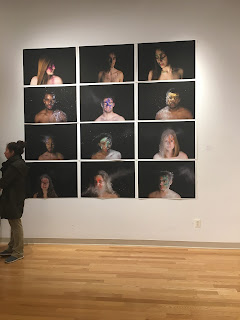Postmodern Mixed Media Visual Analysis
The Jean Baudrillard quote that I began with to create my composition was: "It is always the same: once you are liberated, you are forced to ask who you are". The denotative components to the piece come from the different mixed media that were used to tie it all together. The photo shopped face of the woman combines different pictures to create her face. The thumbprint fills in the shape of her face and the prison bars make up her blank eyes and mouth. Photo shopped eyes were added on top of the bars; one has a reflection of prison bars within them, and one has a tear dripping down. The extension of her hair was first done by using the graphite pencil as well as paint. Then it continues to ink which goes from watered down to saturated ink. There are ink splatters as well covering the extension of the woman's hair. The focal point is the woman's face, and your eye path follows her hair down to the bottom of the piece. The composition is fairly symmetrical, however slightly different aspects make each side differ, such as within the photo shopped face and the lines of the hair. It could also be seen as rule of thirds, divided up by the photo shopped face, the graphite pencil hair, and the ink hair. The color scheme is simple; black, white, and grey.
The connotative meaning comes from the symbolic meanings behind the mixed media. Emotionally, the piece has a dark vibe and forces you to look deeper into each element. Her photo shopped face is the primary symbol from the quote: "It is always the same: once you are liberated, you are forced to ask who you are". The prison bars within the eye and face represent the liberation. The thumbprint background of the face represents being forced to ask who you are. The extension of her hair represents how looking deeper and deeper can change your perspective, and even force you to see things that you may not want to face or accept. The dark, spotty hair is messy and unorganized, unlike her kept hair in the original picture. This then transitions to how we see this piece ideologically. We are forced to conform to a socially accepted set of rules, which hide who we really are inside. Being liberated from these social constructs and accepting yourself as who you are is when we are liberated, however learning who you are without the stereotypes that have imprisoned you before is the challenge. This woman for example might have been stuck in the idea that she needed to look or act a certain way in order to please others on the outside. However, looking deeper and deeper into her, you see the mixed media elements explain how she is trapped behind bars of who she really is. As her hair gets more and more messy, it shows how the deeper and deeper you go, the more we learn about ourselves that we might not like at first, but must learn to accept and embrace.


Comments
Post a Comment